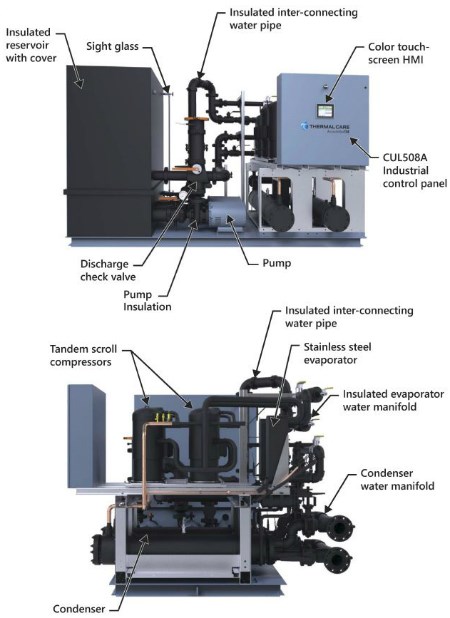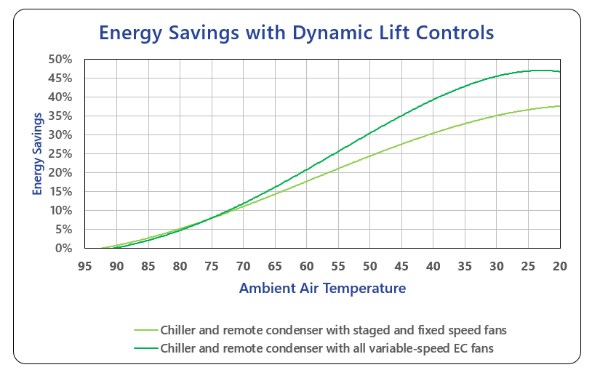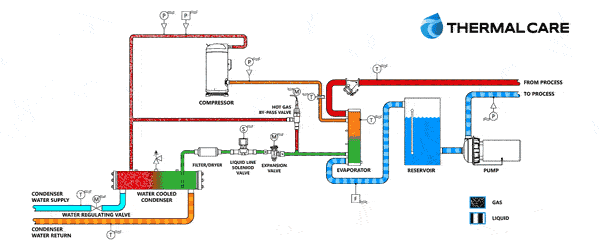Save Energy with New Central Chiller Control Technology
Sponsored ContentMost central chillers run at full capacity all the time, whether you need it or not. But new “Dynamic Lift” control technology dynamically adjusts capacity to meet the need, delivering substantial energy savings to a central cooling system. Here’s how it works.
Share
By Thermal Care
Most plastics processors don’t think much about the chiller in their central cooling systems. But the monthly energy bill usually gets their attention. Question is: What can you do about it?
That out-of-sight, out-of-mind water chiller should be a primary target for energy cost reduction. Simply re-evaluating your plant’s industrial process cooling equipment can be a potential source for cost savings.
No matter how efficient your process is, there will always be some waste heat produced. Removing this waste heat from the product and process equipment quickly and efficiently is the job of a central chiller system; however, not all chillers are the same. The age of the chiller, the type of components it uses, and the control technology all contribute to the chiller system efficiency. As production levels rise and fall, the chiller system must adjust to meet the actual process load.
As the process load decreases, chillers must adjust accordingly to ensure consistent cooling temperatures for the process. That usually involves turning compressors off or using hot gas bypass to keep the compressors running and using power even when the load does not require them to run.
With the added benefit of reducing the operating cost of the chiller system, a better solution to part-load chiller system operation is to reduce the cooling capacity of the system using Dynamic Lift control technology, developed by Thermal Care. Thermal Care is a process cooling manufacturer that provides chilled water equipment for the plastics industry and industrial applications such as injection molding, blow molding, thermoforming and extrusion.
How Chillers Work

Anatomy of a Chiller
The function of a process water chiller is to make cold water to cool a mold or other process equipment. As heat transfers from the process to the water, the water warms up. The chiller uses the warm water as a heat source to boil refrigerant in a part of the chiller called the evaporator.
Due to pressures and the nature of the refrigerant, boiling occurs at cooler temperatures, typically 20° to 70°F. The compressor increases the pressure of the gas and sends it to the condenser. In the condenser, removal of heat from the hot refrigerant gas occurs using ambient air or water from a cooling tower system. As the gas cools, it condenses into a liquid and returns to the evaporator. The temperature at which the gas becomes a liquid depends on the pressure and temperature in the condenser.
Conventional chillers use a fixed pressure setting based on the warmest summertime temperature the condenser may see. As the ambient air is cooled, the chiller turns fans off of the air-cooled condenser or regulates the flow of cooling tower water to maintain the fixed pressure setting for the condenser.
Introducing Dynamic Lift Control
An alternative method is what Thermal Care calls “Dynamic Lift” control technology. This method is used to adjust the pressure in the condenser based on the temperature of the outside air, the process heat load, and the peak efficiencies and performance points of the components in the chiller. While this is similar in function to conventional controls, the dynamic nature of this control technology responds and reacts to changes in any or all of these factors to ensure peak performance and maximum efficiency all year long.

Dynamic Lift controls will typically save an average of 25% reduction on part-load
total chiller energy use at 50°F set point, but how much you save will depend on
your plant’s specific environment as well as the season.
The Dynamic Lift technology continuously calculates the lowest allowable refrigerant pressure for any combination of operating conditions in order to maximize energy savings and provide more stable and smooth refrigerant pressure control, especially under varying load and condenser inlet temperatures. It also adds direct control of remote condenser fans or condenser water regulating valves for added savings.
During testing, Thermal Care found switching from a conventional fixed pressure control method to its Dynamic Lift system resulted in up to 42% greater energy efficiency based on annual weather conditions and a typical manufacturing load condition. Since this solution is almost exclusively control software based, it requires minimal added cost but significant energy and operating cost savings.
Dynamic Lift control is available on Thermal Care’s complete line of indoor central chillers. These include:
- TSE Scroll Compressor Chillers
- TC Centrifugal Compressor Chillers
- MX Rotary Screw Compressor Chillers
Think Energy Savings
As demands grow for energy conservation, it’s critical to find new and inventive ways to eliminate waste. When you consider purchasing a new chiller, remember there are significant operating cost savings possible with the right control technology. Considering process cooling as a whole system, temperature control can have a major impact on energy consumption.
Many chillers use the same type of compressors, evaporators, and condensers, but not all chillers have the advanced control software and energy savings potential as a chiller with Dynamic Lift controls. By automatically adjusting and adapting to variables aforementioned, plastics processors can more efficiently manage changing temperature demands while minimizing waste.
Get more information on Dynamic Lift control technology, and you can directly contact the Thermal Care team there.
